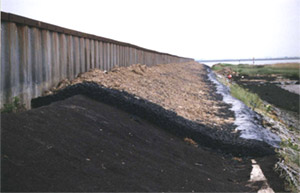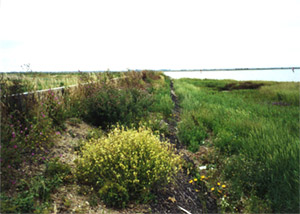Broadlands Flood Alleviation Scheme, River Yare, Great Yarmouth
The flood defence level just upstream of the town on the River Yare’s southern bank was either too low for today’s standards, or too unstable to withstand maximum flood conditions.

The Broadlands area is a highly valued scenic and recreational resource with significant biodiversity so flood protection work had to be completed with minimal environmental impact. Strict weight limits were applied to both delivery vehicles and plant on the crest.
The project was commissioned by The Environment Agency.
Phase 1 (1995) Open Stone Asphalt (OSA) erosion protection to the raised flood embankment.
- Embankment raised and seaward face protected with 150mm OSA on geotextile
- Surface covered with topsoil to encourage plant growth
- Monitoring of structural and environmental performance
Successful performance lead to the contract for Phase 2
Phase 2 (1999) Strengthening of embankment to front and behind existing sheet piled wall

The existing seaward revetment was made of old paving slabs and concrete, with serviceable gabion mattresses below. The area between the mattresses and the sheet piling had to be replaced, but removal of existing materials presented an irregular profile with voids at the top of the mattresses.
- Voids filled with 100mm Lean Sand Asphalt (LSA) to regulate the surface
- 125mm thick OSA armour placed in situ over LSA
- Both materials delivered to, and transported on site in small quantities
- Installation by long-reach mini excavator reduced weight on crest
- Growth of plants promoted by soil-filled trough at top and covering of soil on surface
- 14,000 m2 covered on a 4.6 km seawall
Project manager, Roger Smith, now Hesselberg Hydro’s UK director, said “one of the most challenging elements of the project was the logistics of transporting hot asphalt over long distances in a very exposed location, a task made more difficult by a maximum permitted dumper size of 6 tonne. Waste was kept to a minimum by using specially adapted dumpers and heated skips.”




